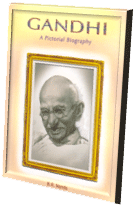
P.O. SEVAGRAM, DIST.WARDHA 442102, MS, INDIA. Phone: 91-7152-284753
FOUNDED BY MAHATMA GANDHI IN 1936
BIOGRAPHY OF GANDHI
GANDHI - A PICTORIAL BIOGRAPHY
by Shri B. R. Nanda

GANDHI
- A PICTORIAL BIOGRAPHY
Shri B. R. Nanda
Table of Contents
- About Gandhi
- Childhood
- Off To England
- Briefless Barrister
- In The 'Dark Continent'
- The Young Politician
- Satyagraha Struggle In South Africa
- The Making Of The Mahatma
- Return To India
- Gandhi's Ashram
- World War I
- Rowlatt Bills
- Nonviolent Non-cooperation
- Arrest And Imprisonment
- Reaction And Recovery
- Declaration Of Complete Independence
- Gandhi-Irwin Pact
- Round Table Conference
- In London
- Resumption Of Struggle
- Campaign Against Untouchability
- A New Deal For The Village
- The New Constitution
- Hindu-Muslim Antagonism
- Nonviolence In A Violent World
- Cripps Mission
- "Quit India"
- Simla Conference
- Cabinet Mission
- Communal Conflagration
- Partition of India
- Mission of Peace
- The End
- Gandhi and Nonviolence
About This Book
This is the first pictorial biography of Gandhi in which the narrative-concise, readable and incisive is illustrated with contemporary photographs and facsimiles of letters, newspaper reports and cartoons, adding up to a fascinating flash-back on the life of Mahatma Gandhi and the struggle for Indian freedom led by him. There is a skilful matching in this book of text and illustrations, of description and analysis and of concrete detail and large perspective. This pictorial biography will revive many memories in those who have lived through the Gandhian era; it should also be of interest to the post-independence generation.
About Author
Shri B. R. Nanda - former Director, Nehru Memorial Museum and Library, New Delhi. His full-scale biography of Mahatma Gandhi has been published in India, Britain and the U.S.A. and translated into French, Spanish, Italian and several other languages
Chapter-23 : Hindu-Muslim Antagonism
During these years Gandhi was also much distressed by the rise in communal tension. To some extent this increased tension was attributable to the elections to the legislatures. The religious minorities were allowed to elect their representatives only from a purely communal electorate, from which adherents of all other religions were excluded. It was only natural that Muslim candidates should raise religious issues which could make the widest and easiest appeal to a largely illiterate electorate. It so happened that from 1937 onwards it suited the All India Muslim League, under the leadership of M.A. Jinnah, to whip up religious feeling. The League had done badly in the elections, but it sought to retrieve its position by launching a tirade against the Congress and Gandhi. Gandhi was alleged to be 'Enemy Number One' of the Muslim community and the British Governors were accused of conniving at a systematic oppression of the Muslim minority by the Hindus. Vague and exaggerated accusations were made about "atrocities" on the Muslims.
The Muslim League's antagonism to the Congress acquired a progressively sharper edge. Jinnah began even to question the suitability of a democratic system of government for India, in 1940 came out with the theory that Hindus and Muslims were two separate nations and the Muslim nation needed a 'homeland' of its own in the north-west and north-east of the sub-continent.
Gandhi's reaction to the two-nation theory and the demand for Pakistan was one of bewilderment, almost of incredulity. Was it the function of religion to separate men or to unite them? He described the two-nation theory as an "untruth"; in his dictionary there was no stronger word. He discussed the attributes of nationality. A change of religion did not change nationality; the religious divisions did not coincide with cultural differences. A Bengali Muslim, He wrote, "speaks the same tongue that a Bengali Hindu does, cats the same food, has the same amusements as his Hindu neighbour. They dress alike. His (Jinnah's) name could be that of any Hindu. When I first met him, I did not know he was a Muslim."
To divide India was to undo the centuries of work done by Hindus and Muslims. Gandhi's soul rebelled against the idea that Hinduism and Islam represented antagonistic cultures and doctrines, and that eighty million of Muslims had really nothing in common with their Hindu neighbours. And even if there were religious and cultural differences, what clash of interests could there be on such matters as revenue, industry, sanitation or justice? The differences could only be in religious usage and observances with which a secular state should have no concern.